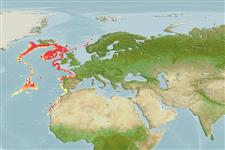Mixini (Missine) (hagfishes) >
Myxiniformes (Hagfishes) >
Myxinidae (Hagfishes) > Myxininae
Etymology: Myxine: Ancient Greek word for a slimy fish: myxa, slime; -inus, one who, referring to copious amounts of slime produced by M. glutinosa. (See ETYFish); ios: Acronym for Institute of Oceanographic Sciences, Wormley, Surrey, England, which supplied holotype. (See ETYFish).
Environment: milieu / climate zone / depth range / distribution range
Ecologia
marino batidemersale; non migratori; distribuzione batimetrica 614 - 1625 m (Ref. 7402). Deep-water; 67°N - 21°N
Eastern Atlantic: southwest off Ireland and Iceland, off Western Sahara.
Size / Peso / Age
Maturity: Lm ? range ? - ? cm
Max length : 57.0 cm TL maschio/sesso non determinato; (Ref. 31276)
Scavengers which are found on muddy bottoms; feed largely on dead or disabled fish by boring into its skin. Eggs are few and large (20-30 mm).
Life cycle and mating behavior
Maturità | Riproduzione | Deposizione | Uova | Fecundity | Larve
Copulatory organ absent. The gonads of hagfishes are situated in the peritoneal cavity. The ovary is found in the anterior portion of the gonad, and the testis is found in the posterior part. The animal becomes female if the cranial part of the gonad develops or male if the caudal part undergoes differentiation. If none develops, then the animal becomes sterile. If both anterior and posterior parts develop, then the animal becomes a functional hermaphrodite. However, hermaphroditism being characterised as functional needs to be validated by more reproduction studies (Ref. 51361 ).
Fernholm, B., 1998. Hagfish systematics. p. 33-44. In J.M. Jørgensen, J.P. Lomholt, R.E. Weber and H. Malte (eds.) The biology of hagfishes. Chapman & Hall, London. 578 p. (Ref. 31276)
IUCN Red List Status (Ref. 130435)
Threat to humans
Harmless
Human uses
Pesca: di nessun interesse
Informazioni ulteriori
Age/Size
Accrescimento
Length-weight
Length-length
Length-frequencies
Morfometria
Morfologia
Larve
Dinamica popolazioni larvali
Reclutamento
Abbondanza
BRUVS
BibliografiaAcquacolturaProfilo di acquacolturaVarietàGeneticaElectrophoresesEreditarietàMalattieElaborazioneNutrientsMass conversion
CollaboratoriImmaginiStamps, Coins Misc.SuoniCiguateraVelocitàModalità di nuotoArea branchialeOtolithsCervelliVista
Strumenti
Special reports
Download XML
Fonti Internet
Estimates based on models
Preferred temperature (Ref.
123201): 3.3 - 8.9, mean 7 °C (based on 91 cells).
Phylogenetic diversity index (Ref.
82804): PD
50 = 0.5000 [Uniqueness, from 0.5 = low to 2.0 = high].
Bayesian length-weight: a=0.00115 (0.00045 - 0.00296), b=3.03 (2.80 - 3.26), in cm total length, based on LWR estimates for this (Sub)family-body shape (Ref.
93245).
Trophic level (Ref.
69278): 3.3 ±0.56 se; based on food items.
Resilienza (Ref.
120179): Basso, tempo minimo di raddoppiamento della popolazione 4.5 - 14 anni (Fec assumed to be <100).
Fishing Vulnerability (Ref.
59153): Moderate vulnerability (43 of 100).
